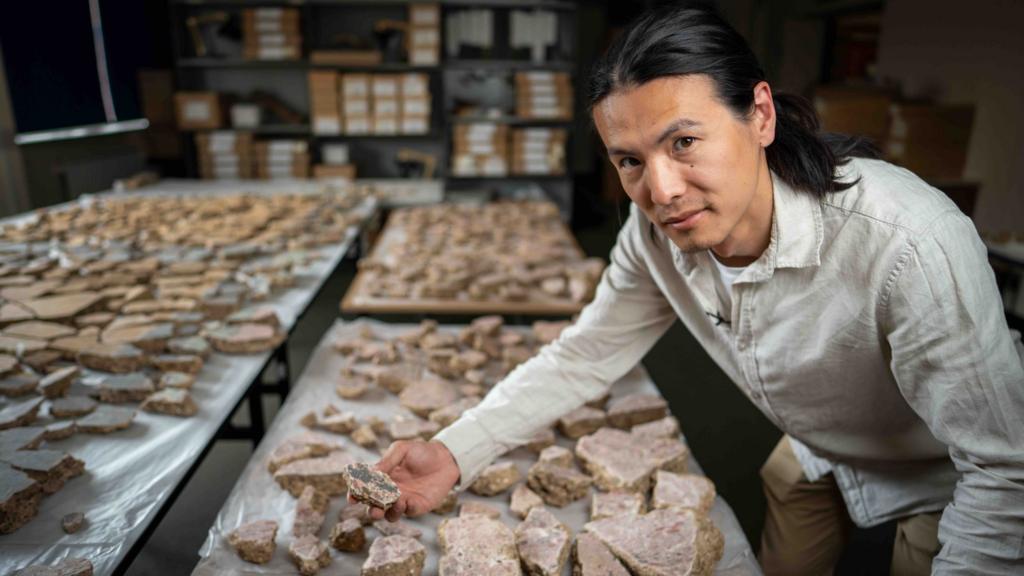Archaeologists have painstakingly reassembled thousands of fragments of 2,000-year-old wall plaster, revealing remarkably preserved frescoes from a luxurious Roman villa.
Unearthed in 2021 during a London redevelopment project, the shattered plaster has yielded a colossal jigsaw puzzle, now meticulously reconstructed.
The frescoes, spanning at least 20 walls, showcase exquisitely detailed depictions of musical instruments, birds, flowers, and fruit.
These vibrant artworks offer significant insights into the affluence of the area, described by the team as the “Beverly Hills of Roman London”.
Clues about the artists’ identities also emerged: one fragment bears the Latin inscription “Fecit” (“has made this”), though the section naming the artist remains missing.
The Museum of London Archaeology (Mola) team maintains hope of discovering this crucial piece amidst the remaining fragments.
“It’s one of the largest, if not the largest, assemblages of Roman wall plaster and paintings ever found in Roman London,” stated Han Li from Mola.
The largest fresco, approximately 5m by 3m, features a pale pink lower section, speckled to mimic marble, topped by rich yellow panels with soft green borders.
The frescoes depict candelabras, lyres (stringed instruments), white cranes, and a delicate daisy.
What initially appeared to be grapes is believed by archaeobotanists to be mistletoe, a locally-grown plant.
“That’s fascinating, showing how Roman painters adapted classical motifs with a distinctly Northwest European, or local, interpretation. I find that magnificent,” notes Han Li.
Li dedicated months to this intricate project, meticulously examining each piece in what he describes as “the world’s most challenging jigsaw puzzle”.
The fragility of the ancient fragments added considerable difficulty.
“Extreme care is necessary; the plaster can only withstand a limited number of manipulations before damage occurs,” he explained.
“Therefore, precise placement is crucial before joining any pieces.”
Founded in AD 43, Londinium saw rapid growth during the first and second centuries, a period when this villa was constructed.
Archaeologists suggest the grand structure may have served as a wealthy family’s residence or a hotel for affluent travelers.
Comparative analysis with frescoes across Britain and Europe suggests the works were created by a team of highly skilled itinerant artists who traversed the Roman Empire.
“They arrived in Roman London during a building boom, undertaking substantial commissions for numerous houses and buildings,” explains Han Li.
“It’s astonishing to think their artistry remains visible to us 2,000 years later.”
However, the artists’ identities remain shrouded in mystery until the missing fragment with their names is recovered.
The plaster was discovered in Southwark, south of the Thames. A stunning mosaic and Roman cemetery were also unearthed at the site, excavated for a new development.
This location, outside central Roman London, sheds light on the city’s expanding boundaries.
“A thriving settlement existed early in the Roman period, resembling a wealthy suburb—the Beverly Hills of Roman London,” says Andrew Henderson-Schwartz from Mola.
“This demonstrates the Romans’ commitment to London, investing in it as a permanent settlement, not merely a provincial outpost.”
Further discoveries from the fresco fragments promise to enrich our understanding of Britain’s rich Roman past.
Get our flagship newsletter with all the headlines you need to start the day. Sign up here.
Scandinavian interior style isn’t all about minimalist living and identikit furniture. Here’s why abundance, exuberance and “luxe cosiness” are all still popular today.
Destroying Iran’s stores of enriched uranium would bring danger for people nearby but not trigger another Chernobyl.
Before the internet took over the world, psychedelic rock band The Grateful Dead were among the first – and most influential – forces at the dawn of online communication.
Ministers are being urged to back the event amid calls for more funding to address safety issues.
Bananarchy is on at Humber Street Gallery until Sunday 21 September.

